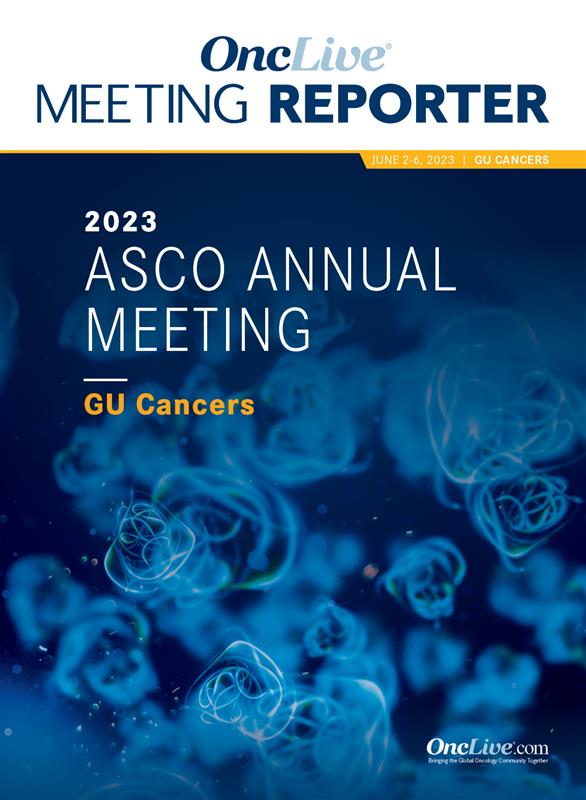Publication
Article
Supplements and Featured Publications
Subsequent Treatments Feasible After Radium-223 in mCRPC
Author(s):
Radium-223 was safe and did not preclude patients with metastatic castration-resistant prostate cancer from receiving subsequent life-prolonging therapies, including chemotherapy.
Daniel Y. Song, MD

Radium-223 (Xofigo) was safe and did not preclude patients with metastatic castration-resistant prostate cancer (mCRPC) from receiving subsequent life-prolonging therapies, including chemotherapy, according to data from an interim analysis of the observational REASSURE trial (NCT02141438).
Findings from the study, which were presented at the 2023 ASCO Annual Meeting, demonstrated that most patients completed 5 to 6 injections of radium-223 and no new safety signals were observed. In addition, treatment with radium-223 resulted in an overall survival of approximately 18 months in patients with mCRPC.
“Our observations in this study show that radium-223 can be integrated into the treatment sequence for patients with mCRPC” Daniel Y. Song, MD, co-director of the prostate cancer multidisciplinary clinic and professor of radiation oncology and molecular radiation sciences at Johns Hopkins Sidney Kimmel Comprehensive Cancer Center in Baltimore, said during the poster presentation.
In this analysis, researchers focused on patients with confirmed metastatic castration-resistant prostate cancer from the U.S. who were scheduled to receive treatment with radium-223. All patients included in this analysis received at least 1 dose of radium-223.
Primary endpoints for this study were short- and long-term safety including second primary malignancies and the incidence of bone marrow suppression. In addition, secondary endpoints included patient-reported pain. Of note, pain response was considered clinically meaningful if it decreased from baseline by at least 2 points in the Brief Pain Inventory-Short Form worst pain item.
Researchers included 498 patients (median age, 74 years) in this analysis who were enrolled in the REASSURE study from 2014 to 2017. The median duration of observation for this analysis was 11.9 months (0.4-41.3) at the data cutoff of March 20, 2019.
In the analysis, 81% of patients had bone metastases only. Between 5 and 6 radium-223 injections were received by 69% of patients.
Most patients — 77% — received at least one prior life-prolonging therapy such as enzalutamide (Xtandi; 48%), abiraterone (Zytiga; 45%), cabazitaxel (Jevtana; 6%), docetaxel (25%) or sipuleucel-T (Provenge; 24%).
Researchers noted that some patients in this analysis received concomitant enzalutamide (Xtandi; 31%) and concomitant bone health agents (47%). Thirty-one percent of patients received at least one life-prolonging therapy after treatment with radium-223.
Song noted that 37% of patients had received prior chemotherapy and 16% of patients who did not receive prior chemotherapy required either therapeutic or preventive treatments for bone marrow suppression. “So, the rate was higher definitely within patients who received prior chemotherapy,” he said.
More than half of the patients (58%) in this analysis who reported a Brief Pain Inventory-Short Form score of 2 or higher at baseline had a clinically meaningful pain response during treatment.
Any-grade drug-related treatment-emergent adverse effects occurred in 32% of patients, whereas adverse events considered grade 3 or worse were observed in 10% of patients. Four percent of patients discontinued treatment with radium-223 as a result of drug-related treatment-emergent adverse effects.
Treatment-emergent serious adverse effects occurred in 21% of patients, and drug-related serious adverse events were observed in 6% of patients. The most common any-grade drug-related treatment-emergent adverse effects, which occurred in 5% or more patients, were fatigue (9%), diarrhea (10%), nausea (7%) and anemia (8%). Song noted in the presentation that these adverse events “were side effects which were known and previously established to be an inherent risk for radium-223.”
Four percent of patients had fractures and 2% developed bone disorders. Eleven second primary malignancies were observed in 10 patients (2%).
During follow-up, 60% of patients died, and the median overall survival was 17.8 months (95% CI 15.6–19.4). Song said that the overall survival in the REASSURE study compares favorably with the ALSYMPCA trial results, which were 14.9 months.
Reference
Song DY, George S, Zimberg, et al. Real-world safety and effectiveness of radium-223 (223Ra) in patients (pts) with metastatic castration-resistant prostate cancer (mCRPC) treated in the US: The non-interventional REASSURE study. J Clin Oncol. 2023;41(suppl 16):5050. doi: 10.1200/JCO.2023.41.16_suppl.5050









